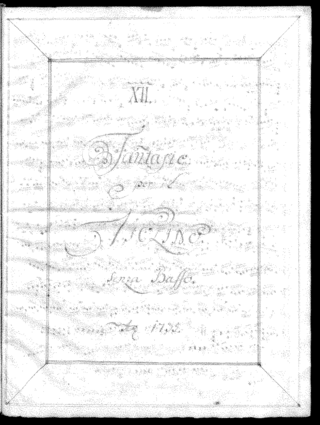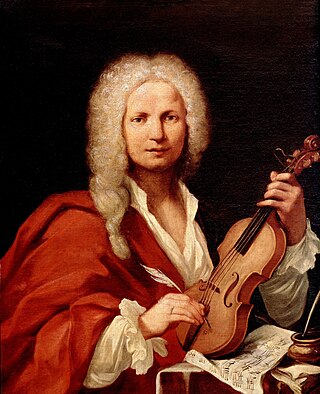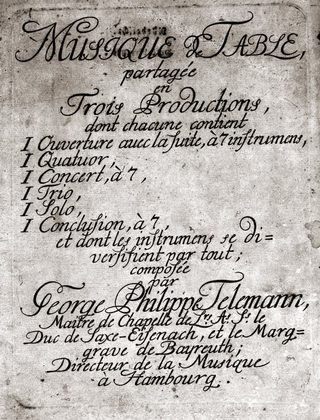Related Research Articles

Georg Philipp Telemann was a German Baroque composer and multi-instrumentalist. He is one of the most prolific composers in history, at least in terms of surviving oeuvre. Telemann was considered by his contemporaries to be one of the leading German composers of the time, and he was compared favourably both to his friend Johann Sebastian Bach, who made Telemann the godfather and namesake of his son Carl Philipp Emanuel, and to George Frideric Handel, whom Telemann also knew personally.

The viola ( vee-OH-lə, Italian:[ˈvjɔːla,viˈɔːla]) is a string instrument that is usually bowed. Slightly larger than a violin, it has a lower and deeper sound. Since the 18th century, it has been the middle or alto voice of the violin family, between the violin (which is tuned a perfect fifth higher) and the cello (which is tuned an octave lower). The strings from low to high are typically tuned to C3, G3, D4, and A4.
A concerto is, from the late Baroque era, mostly understood as an instrumental composition, written for one or more soloists accompanied by an orchestra or other ensemble. The typical three-movement structure, a slow movement preceded and followed by fast movements, became a standard from the early 18th century.

The viola d'amore is a 7- or 6-stringed musical instrument with sympathetic strings used chiefly in the baroque period. It is played under the chin in the same manner as the violin.

A viola concerto is a concerto contrasting a viola with another body of musical instruments such as an orchestra or chamber music ensemble. Throughout music history, especially during the Baroque, Classical, Romantic eras, viola was viewed mostly as an ensemble instrument. Though there were a few notable concertos written for the instrument in this time period, these instances were quite rare and the instrument continued to be ignored. However, during the 20th century, the instrument was revitalized thanks to the work of a number of violists and composers, which led to the commission and composition of many more viola concertos, expanding the repertoire significantly.
Hille Perl is a German virtuoso performer of the viola da gamba and lirone.
A triple concerto is a concerto with three soloists. Such concertos have been composed from the Baroque period, including works by Corelli, Vivaldi, Bach and Telemann, to the 21st century, such as two works by Dmitri Smirnov. The most famous example is Beethoven's Triple Concerto for violin, cello and piano. His combination of solo instruments, a piano trio, was often used also in later works.
Of Georg Philipp Telemann's surviving concertos, his Viola Concerto in G major, TWV 51:G9 is among his most famous, and still regularly performed today. It is the first known concerto for viola and was written circa 1716–1721. Telemann focused on composing for lesser-known instruments, resulting in the composition of this Viola Concerto. Telemann's Concerto for Viola represents a major Baroque concerto, as he explored the soloistic sound of the instrument, allowing it to be viewed as more than just an ensemble instrument. Unlike J.S. Bach and Vivaldi’s standard concerti of three movements, Telemann’s Concerto in G major for Viola contains four movements, and follows sonata da chiesa form, alternating between the tutti and solo sections, a common practice during this period.
New Collegium is a baroque orchestra and chamber ensemble based in The Netherlands. The orchestra was founded in 2006 by Brazilian/Italian harpsichordist Claudio Ribeiro.

Georg Philipp Telemann's collection of 12 Fantasias for Solo Violin, TWV 40:14–25, was published in Hamburg in 1735. It is one of Telemann's collections of music for unaccompanied instruments, the others being twelve fantasias for solo flute and thirty-six for solo harpsichord that were published in Hamburg in 1732–33, as well as a set of twelve fantasias for solo viola da gamba that was published in the same city in 1735, but were considered lost until a copy of the print was found in a private collection in 2015 by viola da gamba player and musicologist Thomas Fritzsch.

Georg Philipp Telemann's 12 fantaisies à traversière sans basse, 12 Fantasias for Solo Flute, TWV 40:2–13, were published in Hamburg in 1732–33. An extant copy of the publication, conserved in Brussels, has a spurious title page reading Fantasie per il Violino senza Basso. The set is one of Telemann's collections of fantasias for unaccompanied instruments, the others being a set of thirty-six for harpsichord, also published in 1732–33, and two sets published in 1735: twelve for solo violin and twelve for viola da gamba.
A double concerto is a concerto featuring two performers—as opposed to the usual single performer, in the solo role. The two performers' instruments may be of the same type, as in Bach's Double Violin Concerto, or different, as in Brahms's Concerto for Violin, Cello and Orchestra.

The Paris quartets is a collective designation for two sets of Chamber music compositions, each consisting of six works for flute, violin, viola da gamba, and continuo, by Georg Philipp Telemann, first published in 1730 and 1738, respectively. Telemann called his two collections Quadri and Nouveaux Quatuors. The collective designation "Paris quartets" was only first bestowed upon them in the second half of the twentieth century by the editors of the Telemann Musikalische Werke, because of their association with Telemann's celebrity visit to Paris in 1737–38. They bear the numbers 43:D1, 43:D3, 43:e1, 43:e4, 43:G1, 43:G4, 43:g1, 43:A1, 43:A3, 43:a2, 43:h1, 43:h2 in the TWV.

La tempesta di mare, a flute concerto in F major, is the first of Six Flute Concertos, Op. 10 by Antonio Vivaldi, published in the late 1720s. La tempesta di mare may also refer to two earlier versions of the same concerto, RV 98, a concerto da camera featuring the flute, from which Vivaldi derived the concerto grosso RV 570.
The Telemann-Werke-Verzeichnis, abbreviated TWV, is the numbering system identifying compositions by Georg Philipp Telemann, published by musicologist Martin Ruhnke.
The concerto transcriptions of Johann Sebastian Bach date from his second period at the court in Weimar (1708–1717). Bach transcribed for organ and harpsichord a number of Italian and Italianate concertos, mainly by Antonio Vivaldi, but with others by Alessandro Marcello, Benedetto Marcello, Georg Philipp Telemann and the musically talented Prince Johann Ernst of Saxe-Weimar. It is thought that most of the transcriptions were probably made in 1713–1714. Their publication by C.F. Peters in the 1850s and by Breitkopf & Härtel in the 1890s played a decisive role in the Vivaldi revival of the twentieth century.

Georg Philipp Telemann's collection of Twelve Fantasias for Viola da Gamba Solo, TWV 40:26–37, was published in Hamburg in 1735, titled Fantaisies pour la Basse de Violle. The fantasias for viola da gamba were considered lost until an original print was found in a private collection in 2015. They were published by Edition Güntersberg in 2016, and first recorded and performed again by Thomas Fritzsch the same year.

Tafelmusik is a collection of instrumental compositions by Georg Philipp Telemann (1681–1767), published in 1733. The original title is Musique de table. The work is one of Telemann's most widely known compositions; it is the climax and at the same time one of the last examples of courtly table music.

There are four church cantatas by Georg Philipp Telemann sharing the title Singet dem Herrn ein neues Lied:
This article lists notable compositions within the viola repertoire. The list includes works in which the viola is a featured instrument. The list is ordered by composer surname.
References
- ↑ Boyden, David; Woodward, Ann (2001). "Viola (Fr. alto; Ger. Bratsche)". Grove Music Online. doi:10.1093/gmo/9781561592630.article.29438. ISBN 978-1-56159-263-0 . Retrieved 28 February 2020.
- ↑ Filmer, Andrew; Bynog, David. "Concerto for Two Violettas" (PDF). americanviolasociety.org. American Viola Society. Retrieved 28 February 2020.